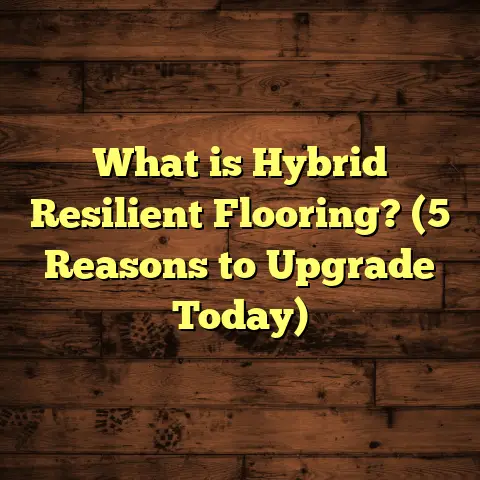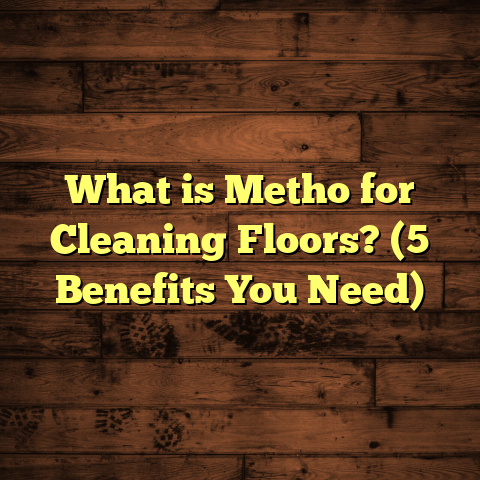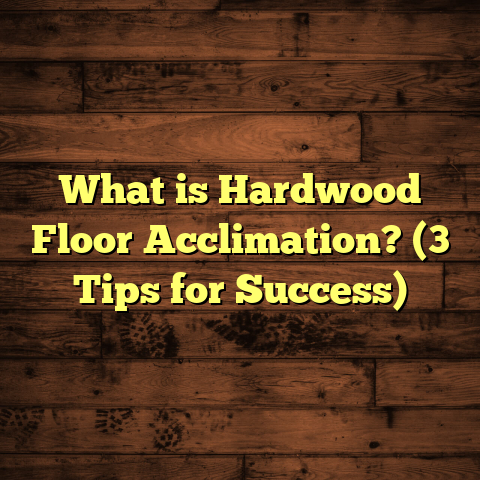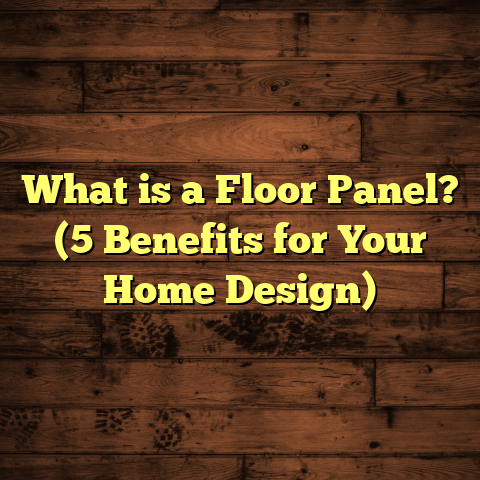What is SPC Flooring? (5 Reasons to Upgrade Your Home)
I remember the struggle I went through when renovating my home a few years ago. The floors in my kitchen and living room were constantly a headache—warping from spills, getting scratched by furniture, and just generally looking worn out after only a few years. I wanted something that could stand up to everyday life, especially with kids and pets around. After trying hardwood and laminate, I kept running into issues that made me question if there was a better option out there. That’s when I stumbled upon SPC flooring. It completely changed my perspective on residential flooring, and I’ve been recommending it ever since.
What is SPC Flooring?
SPC stands for Stone Plastic Composite flooring, sometimes referred to as Stone Polymer Composite. It’s a type of luxury vinyl flooring designed with a rigid core made from limestone powder, polyvinyl chloride (PVC), and stabilizers. This combination creates a dense, durable layer that is both strong and waterproof.
The structure of SPC flooring is what sets it apart from traditional vinyl or laminate floors. Here’s how it’s built:
- Wear Layer: This is the clear top layer that protects the floor from scratches, stains, and fading. Thickness ranges from 0.3 mm to 0.7 mm depending on quality.
- Vinyl Design Layer: Below the wear layer is a printed vinyl sheet that gives the SPC plank its visual design—wood grains, stone textures, or tile patterns.
- SPC Core: The core is a mix of limestone powder and PVC that forms a hard, dense base. This core is what makes SPC flooring so rigid and stable.
- Backing Layer: Usually a foam or cork underlayment that provides sound insulation and comfort underfoot.
SPC floors are engineered to be waterproof, impact-resistant, and dimensionally stable. Unlike laminate which contains fiberboard susceptible to water damage, SPC’s inorganic core won’t swell or warp when exposed to moisture.
1. Durability That Outperforms Traditional Flooring
From my experience working as a flooring contractor and homeowner, durability is one of the biggest reasons people switch to SPC flooring. It’s designed to hold up under heavy traffic, resist dents, and handle impacts better than many other materials.
Why does SPC flooring resist damage so well? The stone plastic composite core has a compression strength of around 1,000 psi (pounds per square inch). To give context:
- Laminate flooring typically handles around 500-600 psi.
- Hardwood floors vary but softer woods can dent easily.
- Traditional vinyl has lower resistance because it lacks a rigid core.
This means that if you accidentally drop something heavy—like a cast iron pan or furniture leg—SPC flooring is less likely to dent or crack. I’ve seen homes where SPC floors have endured years of active kids running around, pets scratching, and furniture moving without significant wear.
Another factor: the wear layer on SPC flooring is thicker than traditional vinyl or laminate. This transparent layer protects against scratches and stains. On some commercial-grade SPC products, wear layers can be as thick as 0.7 mm, which adds serious longevity.
Real-World Case Study: A Restaurant Kitchen
One of the most demanding environments for floors is commercial kitchens. I worked with a restaurant owner who installed SPC flooring in their kitchen area. Despite constant foot traffic, dropped utensils, grease spills, and heavy equipment being moved around weekly, the floor showed minimal wear even after three years.
The owner shared that they spent far less on repairs and replacements compared to their previous rubber matting and tile floor.
2. Waterproof and Perfect for Moisture-Prone Areas
If you’ve ever dealt with water damage on wood or laminate floors, you know how frustrating it can be. Warping, swelling, buckling—it’s an expensive headache. SPC flooring eliminates that worry because it’s 100% waterproof.
The inorganic stone composite core doesn’t absorb water. Even if water pools on the floor for hours or days, the structure remains intact without swelling or warping.
In my own home renovation—after a minor pipe leak in the bathroom—the water sat on our SPC floor for almost two days before we noticed. To my surprise, there was zero damage or discoloration afterward.
How Does It Compare?
- Hardwood floors: Water causes irreversible warping and cupping.
- Laminate floors: The fiberboard core absorbs moisture and swells.
- Traditional vinyl: Waterproof but tends to be less durable overall.
- SPC flooring: Both waterproof and highly durable due to its core.
Data Point
According to Flooring America’s product testing data, SPC floors can withstand direct water exposure for up to 72 hours without compromising structural integrity or appearance—a critical advantage in kitchens, bathrooms, basements, laundry rooms, or mudrooms.
Personal Experience: Basement Installation
I installed SPC flooring in a client’s basement that had a history of minor flooding during heavy rains. They were previously reluctant to use hardwood or laminate due to moisture risk. After two years with SPC installed, they reported zero issues even after several rain-related floods.
3. Ease of Installation — DIY Friendly and Contractor Approved
One thing I always look for is how easy it is to install new flooring because installation costs can easily double your budget.
SPC flooring generally features a click-lock system that allows planks to snap together without glue or nails. This floating installation method means you can lay the floor over most existing subfloors such as concrete or plywood with minimal prep work.
The rigid core also means fewer problems with uneven subfloors compared to flexible vinyl sheets or thinner laminate planks. When I first installed SPC in my own home’s kitchen, I was able to complete the job myself over a weekend after watching a few tutorial videos.
Installation Time
For professional installers:
- Small rooms (100-200 sq ft) often take 4-6 hours.
- Larger rooms (400+ sq ft) can be done in 1-2 days depending on layout complexity.
This compares favorably against hardwood installations which usually require nailing/gluing plus sanding and finishing—often taking multiple days.
Cost Savings
Because installation is faster and less labor-intensive:
- You save on labor costs—typically $2-$5 per sq ft less than hardwood installation.
- Less downtime for your home renovation project.
- Lower risk of installation errors damaging the floor.
I’ve seen many homeowners successfully do partial installations themselves with minimal tools: just a tapping block, pull bar, spacers, and saw for cutting planks.
4. Realistic Designs That Look Great
A big reason people hesitate about vinyl-based products is fear they’ll look cheap or fake. Over the years, SPC manufacturers have massively improved the printed vinyl design layer quality.
Today’s SPC floors feature high-resolution photographic prints paired with embossed textures that replicate wood grain, stone veins, slate ridges, or tile grout lines in remarkable detail.
Examples From My Projects
I installed an oak-look SPC floor for a client who wanted a rustic farmhouse vibe without sacrificing durability. The texture felt so real underfoot that visitors often commented they couldn’t tell it wasn’t actual hardwood.
Another client chose slate-look SPC tiles for their mudroom because they wanted easy cleanup but still wanted natural stone aesthetics at a fraction of the cost.
Color & Style Variety
SPC floors come in:
- Warm wood tones like maple, hickory, cherry
- Cool grays and bleached woods popular in modern design
- Natural stone looks like granite or limestone
- Classic tile patterns including hexagons and checkerboards
This variety means you can find options that fit any interior style—traditional, contemporary, rustic, or industrial.
UV Resistance
One concern with vinyl products has been fading from sunlight exposure over time. Most quality SPC flooring includes UV inhibitors in their wear layers preventing color fade even after long-term exposure to direct sunlight.
5. Low Maintenance That Fits My Busy Lifestyle
From the start of my renovation journey until now, maintenance has always been a key factor in choosing floors. I don’t want to spend hours scrubbing or worrying about ruining my investment with simple daily activities.
SPC flooring requires very little maintenance:
- Sweep or vacuum regularly to remove debris.
- Mop occasionally with mild soap and water.
- Avoid abrasive cleaners or harsh chemicals.
The wear layer resists stains from common household spills like coffee, wine, juice, pet accidents, and dirt. I’ve witnessed clients leave red wine spilled on their SPC floor for hours without staining—a relief for families with children!
Longevity
Industry studies show that with proper care:
- SPC floors maintain appearance for 15–20 years in residential settings.
- Commercial installations can last even longer due to thicker wear layers.
In contrast:
- Hardwood may need refinishing every 7–10 years.
- Laminate often shows wear within 5–7 years under heavy use.
Diving Deeper: How SPC Flooring Performs in Different Environments
Residential Homes
For busy families with kids and pets like mine:
- Durability helps withstand scratches from toys or claws.
- Waterproofing prevents damage from spills or accidents.
- Easy cleaning fits hectic schedules.
I recommend SPC especially for kitchens, living rooms, basements, bathrooms—areas prone to moisture or heavy traffic.
Commercial Spaces
Retail stores, offices, hotels benefit from:
- High wear-layer options providing commercial-grade scratch resistance.
- Easy installation reducing downtime during renovations.
- Sound absorption layers improving acoustics in busy environments.
One office project I worked on used SPC flooring throughout its conference rooms because it looked professional yet offered excellent durability under heavy footfall.
Rental Properties
Landlords often choose SPC flooring because:
- Tenants are less likely to cause costly damage.
- Easy cleaning reduces turnover preparation times.
- Long lifespan lowers replacement frequency.
Environmental Considerations: Is SPC Flooring Eco-Friendly?
This is a question I get asked frequently by environmentally conscious clients.
SPC flooring includes PVC (polyvinyl chloride) which raises concerns about chemical emissions and recyclability. However:
- Many manufacturers now produce low-VOC (Volatile Organic Compound) SPC products certified by programs like FloorScore® ensuring indoor air quality.
- Limestone powder used in the core is an abundant natural mineral reducing PVC content overall.
- Some brands participate in recycling programs though widespread recycling infrastructure for vinyl floors remains limited compared to wood or tile.
If sustainability is your top priority but you still want durability and water resistance, look for brands offering third-party certifications and transparent material disclosures.
Comparing SPC Flooring with Other Popular Options
Let’s look closer at how SPC compares with other common residential floors:
| Feature | SPC Flooring | Hardwood | Laminate | Traditional Vinyl | Tile |
|---|---|---|---|---|---|
| Water Resistance | Fully waterproof | None | Water-resistant but swells | Water-resistant | Fully waterproof |
| Durability | Very high | Moderate (softwoods dent) | Moderate | Lower durability | Extremely durable |
| Scratch Resistance | High | Moderate | Moderate | Low | Very high |
| Installation | Click-lock (DIY friendly) | Nails/glue + sanding needed | Click-lock | Glue-down or click-lock | Mortar + grout needed |
| Maintenance | Low | Moderate (polishing required) | Low | Low | Low |
| Appearance | Highly realistic wood/stone | Natural wood grain | Good but less authentic | Varies | Natural stone/glass |
| Cost per sq ft | $3–$7 | $5–$15+ | $1–$4 | $1–$3 | $3–$10+ |
| Noise Level | Moderate; can add underlayment | Moderate | Moderate | Moderate | High (hard surface) |
| Comfort Underfoot | Moderate (with padding) | Warm & natural | Hard | Hard | Hard |
Why Choose SPC Over Hardwood?
Hardwood offers classic beauty but requires more upkeep—a finish wears down over time needing sanding/refinishing. It’s vulnerable to moisture damage which makes it unsuitable for kitchens/bathrooms unless sealed carefully.
SPC offers easier maintenance, improved durability against dents/scratches, and full waterproofing while still mimicking wood aesthetics convincingly.
Why Choose SPC Over Laminate?
Laminate floors are budget-friendly but sensitive to water damage. They also tend to sound hollow underfoot unless paired with thick underlayment. Compared with laminate:
- SPC has better waterproofing.
- Higher impact resistance.
- More realistic visuals due to textured surfaces.
Why Not Just Use Traditional Vinyl?
Traditional vinyl sheets or planks are usually more flexible but lack rigidity leading to dents or tears over time. SPC combines vinyl’s waterproof benefits with a strong stone composite core preventing damage from heavy impacts or furniture movement.
Why Not Tile?
Tile is durable and waterproof but can be cold/hard underfoot and more expensive both in material and labor costs. Tiles are prone to cracking if subfloor shifts occur and grout can stain/become moldy over time.
SPC provides warmth underfoot with some cushioning (depending on backing) plus easier installation without messy grout work.
Personal Stories from My Clients Using SPC Flooring
I want to share some real feedback from homeowners who chose SPC floors:
- “We installed SPC flooring in our kitchen after two hardwood floors got ruined by spills. It looks amazing and withstands all our cooking messes!” – Sarah M., homeowner
- “Our basement floods occasionally due to rainwater seepage but our new SPC floor hasn’t shown any signs of swelling or damage even after months.” – Mike T., contractor client
- “As landlords managing multiple rentals, switching to SPC saved us thousands in repairs each year.” – Linda R., property manager
Hearing these stories confirms why I trust this product so much.
Technical Insights: Breaking Down the Science Behind SPC Flooring
To understand why SPC performs so well let’s look closer at its composition:
The Core: Stone Plastic Composite
The core material combines limestone powder (<del>60–70%) with PVC resin (</del>30–35%) and stabilizers (~1–5%). Limestone adds strength and rigidity while PVC binds it all together providing flexibility enough to prevent cracking but firmness to resist dents.
Wear Layer Technology
Modern wear layers use urethane coatings embedded with aluminum oxide crystals for scratch resistance—a technology borrowed from hardwood finishes but adapted for vinyl surfaces.
Impact Resistance Testing
In lab tests using ball-drop impact methods simulating heavy object drops:
- SPC showed minimal surface deformation compared with laminate which often cracked or chipped.
- Wear layers resisted abrasion exceeding industry standards by up to 50%.
These factors make it reliable even under harsh household conditions.
Tips For Choosing Quality SPC Flooring
If you decide on SPC flooring here are some tips I always share:
- Check Wear Layer Thickness: Aim for at least 0.5 mm for residential use; thicker layers last longer especially in high traffic areas.
- Look for Certifications: FloorScore®, GreenGuard Gold indicate low VOC emissions—better indoor air quality.
- Consider Core Thickness: Standard cores range from 4 mm to 8 mm; thicker cores provide better sound insulation and comfort.
- Sample First: Order samples from manufacturers to see color/texture in your home lighting before committing.
- Warranty: Select products offering long-term warranties (10+ years) reflecting manufacturer confidence.
Maintaining Your SPC Floor Like a Pro
Here are some maintenance hacks I’ve learned over years installing these floors:
- Use felt pads under furniture legs to prevent scratches during moves.
- Clean up spills immediately but don’t panic if left longer since water won’t damage the core.
- Avoid steam mops; excessive heat can degrade vinyl layers over time.
- Use pH-neutral cleaners designed for vinyl; avoid abrasive scrubbers.
Following these simple steps keeps your floor looking fresh year after year.
Final Comparison Thoughts: Which Flooring Is Right For You?
Choosing between flooring types comes down to priorities like budget, appearance preference, durability needs, moisture exposure risk, lifestyle factors (kids/pets), and installation logistics.
Here’s how I’d summarize:
| Situation/Need | Recommended Flooring |
|---|---|
| Want authentic natural wood | Hardwood |
| Budget-conscious & dry areas | Laminate |
| Need waterproof & durable | SPC Flooring |
| Lowest cost & easy replacement | Traditional Vinyl |
| Extremely durable & cold/hard | Tile |
For many homeowners balancing style with practical needs like durability and water resistance—SPC flooring hits the sweet spot.
If you want help calculating costs or exploring specific products based on your home size or style preferences, feel free to ask—I’m happy to guide you through options tailored just for your project!





